
Concept explainers
(a)
Interpretation:
The IUPAC name for the structure is to be given.
Concept introduction:
In the
Answer to Problem A.30P
The correct IUPAC name for the structure is
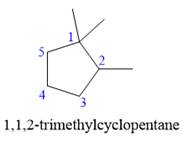
Explanation of Solution
The given structure is
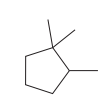
In the structure above, the ring has more carbon atoms than any of the straight chain groups. Hence, the root name of this structure is “cyclopentane.” The carbon atom of this ring, which is attached to two methyl groups, will be numbered as
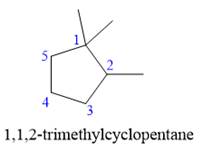
The correct IUPAC name for the given structure is
(b)
Interpretation:
The IUPAC name for the structure is to be given.
Concept introduction:
In the IUPAC nomenclature, the longest continuous carbon chain or the largest carbon ring is considered as the parent chain. The name of this corresponding parent chain/ring will be the root of the molecule’s name. Identify the substituents and add the name of the substituent as a prefix to the left of the root. The number assigned to the carbon that is bonded to the substituent is called the locator number or locant. In case of two or more different substituents, the alphabetical order is considered. Number each carbon atom of the chain sequentially, beginning with
Answer to Problem A.30P
The correct IUPAC name for the structure is
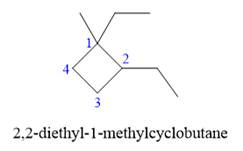
Explanation of Solution
The given structure is

In the above structure, the ring has more carbon atoms than any of the straight chain groups. Hence, the root name of this structure is “cyclobutane.” The carbon atom of this ring, which is attached to two substituents, will be numbered as
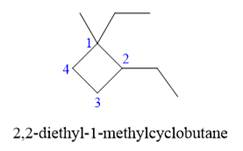
The correct IUPAC name for the given structure is
(c)
Interpretation:
The IUPAC name for the structure is to be given.
Concept introduction:
In the IUPAC nomenclature, the longest continuous carbon chain or the largest carbon ring is considered as the parent chain. The name of this corresponding parent chain/ring will be the root of the molecule’s name. Identify the substituents and add the name of the substituent as a prefix to the left of the root. The number assigned to the carbon that is bonded to the substituent is called the locator number or locant. In case of two or more different substituents, the alphabetical order is considered. Number each carbon atom of the chain sequentially, beginning with
Answer to Problem A.30P
The correct IUPAC name for the structure is
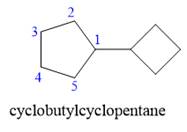
Explanation of Solution
The given structure is

In the structure above, two rings are present. The ring on the left has more number of carbon atoms than the ring on the right; hence the root name of this compound is “cyclopentane.” The carbon atom of this cyclopentane ring to which the cyclobutane ring is attached will be numbered as

The correct IUPAC name for the given structure is
(d)
Interpretation:
The IUPAC name for the structure is to be given.
Concept introduction:
In the IUPAC nomenclature, the longest continuous carbon chain or the largest carbon ring is considered as the parent chain. The name of this corresponding parent chain/ring will be the root of the molecule’s name. Identify the substituents and add the name of the substituent as a prefix to the left of the root. The number assigned to the carbon that is bonded to the substituent is called the locator number or locant. In case of two or more different substituents, the alphabetical order is considered. Number each carbon atom of the chain sequentially, beginning with
Answer to Problem A.30P
The correct IUPAC name for the structure is
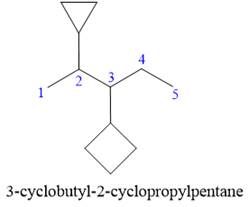
Explanation of Solution
The given structure is
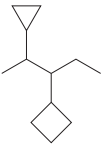
In the structure above, there are two rings and a straight chain of carbon atoms. Out of these, the straight continuous carbon chain has more atoms than any of the rings. Hence, the straight chain carbon will serve as the parent, and the two rings will serve as substituents. Thus, the root name of this structure is “pentane.” The numbering of this parent chain should start from the left as the substituent encountered receives the lowest possible locator number. The two substituents are attached on the
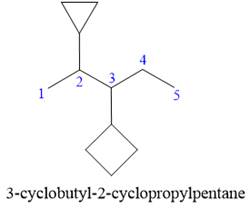
The correct IUPAC name for the given structure is
(e)
Interpretation:
The IUPAC name for the structure is to be given.
Concept introduction:
In the IUPAC nomenclature, the longest continuous carbon chain or the largest carbon ring is considered as the parent chain. The name of this corresponding parent chain/ring will be the root of the molecule’s name. Identify the substituents and add the name of the substituent as a prefix to the left of the root. The number assigned to the carbon that is bonded to the substituent is called the locator number or locant. In case of two or more different substituents, the alphabetical order is considered. Number each carbon atom of the chain sequentially, beginning with
Answer to Problem A.30P
The correct IUPAC name for the structure is
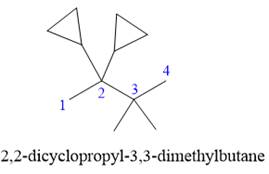
Explanation of Solution
The given structure is
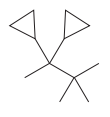
In the structure above, the straight continuous chain of carbon atoms will serve as the parent as it contains the highest number of carbon atoms than the rings. Hence, the root name of this structure is “butane.” There are two types of substituents attached- cyclopropyl and methyl. As the prefix “cyclo” is considered while naming, it will appear first in the IUPAC name. Thus, the numbering will also start from the left so that the carbon atom with two cyclopropyl rings will get the lowest possible locator numbers. The prefix di will be used for both the substituents as they appear twice. Thus, the IUPAC name for this structure is
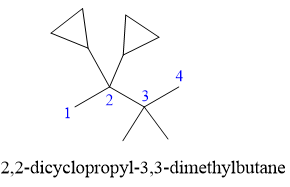
The correct IUPAC name for the given structure is
Want to see more full solutions like this?
Chapter A Solutions
EBK ORGANIC CHEMISTRY: PRINCIPLES AND M
- A mixture of C7H12O2, C9H9OCl, biphenyl and acetone was put together in a gas chromatography tube. Please decide from the GC resutls which correspond to the peak for C7,C9 and biphenyl and explain the reasoning based on GC results. Eliminate unnecessary peaks from Gas Chromatography results.arrow_forwardIs the molecule chiral, meso, or achiral? CI .CH3 H₂C CIarrow_forwardPLEASE HELP ! URGENT!arrow_forward
- Identify priority of the substituents: CH3arrow_forwardHow many chiral carbons are in the molecule? OH F CI Brarrow_forwardA mixture of three compounds Phen-A, Acet-B and Rin-C was analyzed using TLC with 1:9 ethanol: hexane as the mobile phase. The TLC plate showed three spots of R, 0.1 and 0.2 and 0.3. Which of the three compounds (Phen-A; Acet-B or Rin-C) would have the highest (Blank 1), middle (Blank 2) and lowest (Blank 3) spot respectively? 0 CH: 0 CH, 0 H.C OH H.CN OH Acet-B Rin-C phen-A A A <arrow_forward
